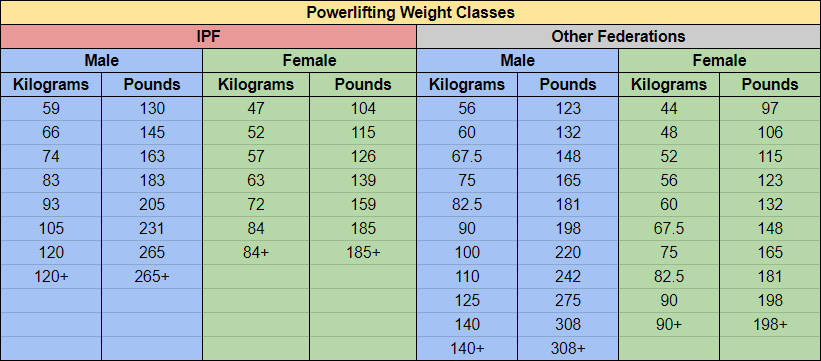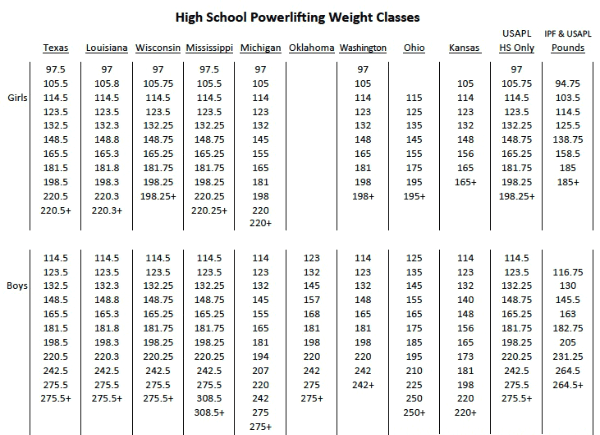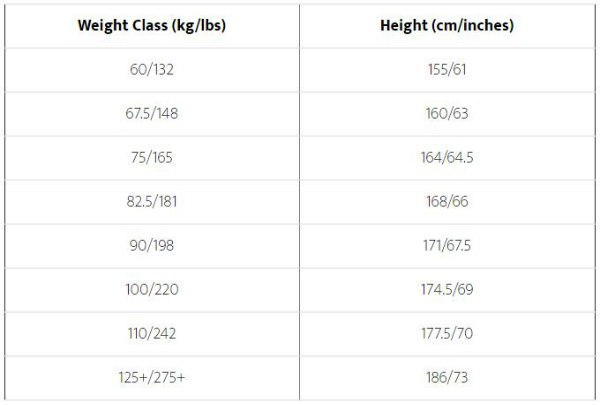
Powerlifting is a divided sport, but not in a bad way. Weight classes keep things interesting and competitive for everyone.
However, they aren’t universally standard and can vary from federation to federation. They also vary depending on whether you are a male or female competitor.
With that said, the main classifications are USAPL and non-USAPL. Additionally, powerlifters in high school also follow a different standard.
USAPL (USA Powerlifting) and IPF (International Powerlifting Federation) Weight Classes

Credit to PLTW for compiling this chart.
The classifications for USAPL, IPF, and regional federations such as the NAPF (North American Powerlifting Federation) are all the same.
For any given class, you must weigh equal or less than the class you intend to compete in. For example, if you intend to lift in the 83kg/183lbs class you must weight exactly 83kg/183lbs or less.
Pounds
Men:
- 116lbs (junior and sub-junior lifters only)
- 130lbs
- 145lbs
- 163lbs
- 183lbs
- 205lbs
- 231lbs
- 265lbs
- 265+lbs
As described above, women’s powerlifting weight classes are slightly different than those for males.
Women:
- 94lbs (junior and sub-junior lifters only)
- 104lbs
- 115lbs
- 126lbs
- 139lbs
- 159lbs
- 185lbs
- 185+lbs
Kilograms
Men:
- 53kg (only applies to sub-junior and junior powerlifters)
- 59kg
- 66kg
- 74kg
- 83kg
- 93kg
- 105kg
- 120kg
- 120+kg
Women:
- 43kg (only applies to sub-junior and junior powerlifters)
- 47kg
- 52kg
- 57kg
- 63kg
- 72kg
- 84kg
- 84+kg
USPA Powerlifting Weight Classes (And All Other Non-IPF Federations)
Non-IPF powerlifting federations prescribe to a slightly-different scale. If you are not competing in the USPA make sure to check with your individual federation’s website just in case it differs.
Pounds
Men:
- 123lbs
- 132lbs
- 148lbs
- 165lbs
- 181lbs
- 198lbs
- 220lbs
- 242lbs
- 275lbs
- 308lbs
- 308+lbs
Women:
- 97lbs
- 106lbs
- 115lbs
- 123lbs
- 132lbs
- 148lbs
- 165lbs
- 181lbs
- 198lbs
- 198+lbs
Kilograms
Men:
- 56kg
- 60kg
- 67kg
- 75kg
- 82kg
- 90kg
- 100kg
- 110kg
- 125kg
- 140kg
- 140+kg
Women:
- 44kg
- 48kg
- 52kg
- 56kg
- 60kg
- 67kg
- 75kg
- 82kg
- 90kg
- 90+kg
High School Powerlifting Weight Classes
If you are a high school powerlifter, your weight classes will also be different. Additionally, it varies from state to state and depends on the federation in question. While the table below is accurate, make sure to check with your local federation to ensure you have the most up-to-date standards.

Credit to Powerlifting High for compiling this table.
Powerlifting Weight Classes: Which Should You Choose?
Fat guys grunting in dungeon-esque gyms. Ah, the glory days…or not.
What made sense 10 or 20 years ago simply doesn’t apply today. And yet, many people continue to spread the falsehood that more weight is always better.
The central question is simple: should you lose or gain weight to put yourself into a specific class?
- If you are a geared lifter and wear squat suits and bench shirts, additional fat may be helpful to fill out your gear and improve leverages.
- If you are a raw lifter, beyond a shadow of a doubt, compete as lean as you possibly can.
Why?
Muscle contracts and produces force—fat doesn’t. Having additional fat will do absolutely nothing towards your total and will simply push you into a higher weight class.
This is largely based on the faulty argument that fat will “improve your leverages”. This simply isn’t true; fat is not dense at all and compresses very easily. For heavyweight lifters who border on obese, this may be true to some extent as range of motion can be limited on bench press and squat due to a large gut.
Being fat will also allow you to hold more water, however, which is not compressible and will improve leverages. But the tradeoff is far from worth it; being fat simply to hold more water is self-sabotaging and will not lead to nearly enough of a performance increase to make it worth it—not even close.
For some reason, the powerlifting community has popularized the idea that gaining as much weight as you can handle is the only way to an elite level wilks (height also comes into play—explained below).
At the end of the day though, experience always beats out opinion. Try it out for yourself: gain an extra 20-30 pounds and see if it makes you stronger. It definitely will, but not even close to the relative amount of weight gain. And now you’ll be competing against absolute monsters who should actually be in that class.
Still not convinced?
Take a look at the performance of the most recent USAPL nationals competition. Find your weight class and then look at the classes above and below. You will quickly realize that being as lean as possible is the absolute best answer.
But we’ll break it down even further with an example.
Say you’re 190 pounds at roughly 12-13% bodyfat (not lean) with a total of 1450. This would give you the option to compete in one of three classes:
- 74kg/163lbs: cut down to sub-10% body fat
- 83kg/183lbs: cut slightly, still above 10% body fat
- 93kg/205lbs: gain weight, 15%+ bodyfat
The top lifters from each class totaled:
- 74kg = 1,578.5 pounds (Steven Lehew)
- 83kg = 1,744.6 pounds (Russel Orhii)
- 93kg = 1,848 pounds (Ashton Rouska)
After looking at the numbers makes it glaringly obvious: gaining fat makes absolutely no sense. And so does only cutting slightly.
As a raw lifter, you should be competing as lean as you possibly can (10% body fat or less) to put yourself in one of the lightest powerlifting weight classes possible.
But the best answer is always based on science. And the science makes it very clear that building muscle is a long-term process. You cannot expect to gain pounds upon pounds of lean, dense muscle in a short period of time. The only caveat to that is a complete beginner who will experience “noob gains” and progress very quickly.
But if you’ve been powerlifting for 6 months or longer, you have already depleted your noob gains and can expect to gain .25-1 pound of actual lean body mass every month. This equates to 3-12 pounds of lean body mass per year. The more of a novice you are, the more your results will border on the larger side of that scale.
Coming to terms with this reality is important. But think about it: gaining 3-12 pounds of dense muscle every year is a lot. Unfortunately, the gimmicky marketing of the fitness industry has inflated people with falsehoods of gaining “slabs” and pounds of thick muscle in mere weeks. It simply doesn’t work like that.
Knowing that building muscle is a long-term gain, we can be absolutely confident that any level of rapid weight gain will mostly be fat. And we know fat doesn’t produce any force. So why would you happily accept more weight that does very little for you? If you’re smart, you wouldn’t. Train hard, build muscle, but keep a reasonable level of fat so that when meet day comes—you can cut down to sub-10%.
Height also comes into play, however.
The shorter you are, the more of your weight will be actual soft tissues (muscles, tendons, ligaments) as opposed to structural (bones, organs, etc.). This means a 5’7” lifter at 190 pounds will always have more “usable” mass than a 5’10” lifter at 190 pounds. With that said, this phenomenon truly only comes into play at the most elite levels of powerlifting (think IPF worlds).
If you are attempting to reach elite (450 wilks score) or world-renowned (500 wilks score) strength levels, height is a factor.

Truly world-class strength requires a short stature. Luckily, for almost everyone else it doesn’t matter nearly as much.
If you are competing in the USAPL or any other federation, height should not be factored in when considering your weight class. The only exception would be very tall lifters—who should be competing at a weight appropriate for their body (a.k.a. a 6’2” person should not be in the 74kg class—that just doesn’t make sense).
Examples always help to drive a point home:
- Jesse Norris is “too tall” for the 93kg weight class if you consider his height of 5’9”—and yet he is one of the strongest men for his class to walk the earth
- Josh Hancott is “way too tall” for the 74kg weight class with his height of 5’9”—and yet he has been one of the most dominant 74kg lifters in recent history
Bottom line: don’t worry about your height unless it is extreme. Compete as lean as you can.
Taking a look at Dan Green and Jesse Norris during their competition phases drives the point home even more.

These elite-level lifters compete at sub-10% body fat.
They clearly understand that being lean is best—and dominate their weight classes with ease using this knowledge.
Powerlifting Diet for the Best Weight Class
Now that you understand what powerlifting weight classes are available to you and know that being as lean as possible is always best, taking a look at proper powerlifting nutrition will provide you with a solid game plan to reach your desired weight.
One of the main issues with losing weight as a strength athlete is the loss of muscle mass. It is inevitable, but luckily there is one main way to stop it: lift heavy. Luckily, powerlifting is all about lifting heavy! By simply following the correct powerlifting routine that includes weights at 80% or higher than your 1RM, you will ensure proper stimulation to retain muscle.
Furthermore, based on research conducted by the Journal of the International Society of Sports Nutrition we know that a loss of .5-1% of bodyweight per week is optimal to maximizing muscle retention. For example, if you are a 200 pound lifter you should aim to lose 1-2 pounds per week. By losing weight at this slower pace, your body is able to hold onto its muscle and instead burn fat and carbohydrates.
The plan then becomes very simple:
- Continue to train using your powerlifting program
- Determine the weight class you need to drop down to
- Determine your TDEE (total daily energy expenditure or amount of calories you consume)
- Monitor your weight and adjust calories as necessary
How do you determine your TDEE? Simple.
First calculate your BMR or basal metabolic rate:
For males: BMR = (height in centimeters * 6.25) + (weight in kilograms * 9.99) – (age * 4.92) + 5
For females: BMR = (height in centimeters * 6.25) + (weight in kilograms * 9.99) – (age * 4.92) – 161
Next, calculate your TDEE by multiplying your BMR times your activity and fitness level:
TDEE = BMR * activity level
For females:
- Sedentary lifestyle (very little or no exercise): BMR * 1.1
- Light activity lifestyle (exercise 1-3 days per week): BMR * 1.275
- Moderate activity lifestyle (exercise 3-5 days per week): BMR * 1.35
- High activity lifestyle (exercise 6-7 days per week): BMR * 1.525
For males:
- Sedentary lifestyle (very little or no exercise): BMR * 1.2
- Light activity lifestyle (exercise 1-3 days per week): BMR * 1.375
- Moderate activity lifestyle (exercise 3-5 days per week): BMR * 1.55
- High activity lifestyle (exercise 6-7 days per week): BMR * 1.725
- Extreme activity lifestyle (exercise multiple times per day, physical job): BMR * 1.9
This will leave you with a base number to start with. From there you can easily adjust your calories up or down slightly (100-200 calories at a time) to make sure you are losing weight at the proper pace of 1-2 pounds per week.
But wait…this seems really simple, almost too simple? That’s because it is!
The fitness community has convinced everyone that losing weight is complicated. This couldn’t be farther from the truth. Physiqz coaches have used this approach for countless clients and it works every single time.
Now you know what the weight classes are, which to choose, and how to make it happen.
